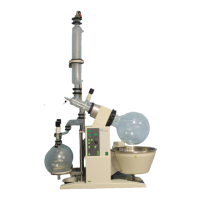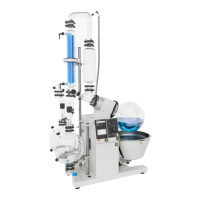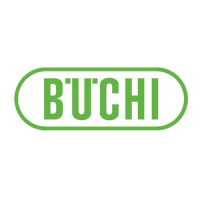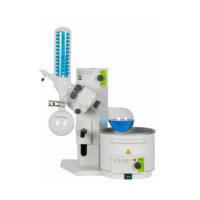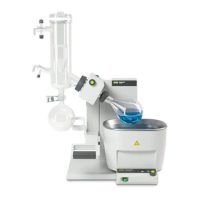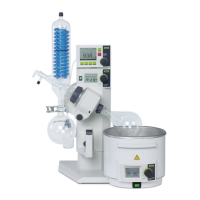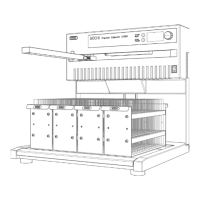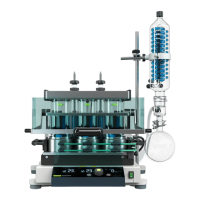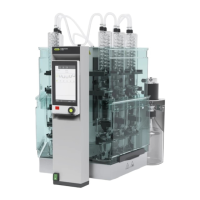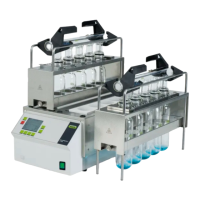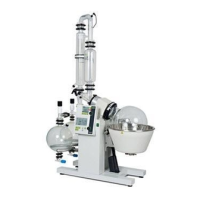
Do you have a question about the Buchi Rotavapor R-220 SE and is the answer not in the manual?
| Type | Rotary Evaporator |
|---|---|
| Heating Bath | Yes |
| Rotation Speed | 20 to 280 rpm |
| Display | Digital |
| Temperature Range | Ambient +5°C to 180°C |
| Lift type | Motorized |
| Automatic distillation | Optional |
| Bath Temperature Range | Ambient +5°C to 180°C |
| Cooling Coil Temperature Range | Depends on coolant used |
| Voltage | 100-240 V |
| Evaporation Capacity | Up to 5 L |
Defines the required qualifications for operating the instrument safely and effectively.
Outlines the intended applications and authorized uses of the rotary evaporator.
Lists forbidden applications and defines what constitutes improper use of the instrument.
Explains standardized signal words (DANGER, WARNING, CAUTION, NOTICE) and their meanings.
Highlights general hazards, warning labels, personal safety measures, and built-in safety features.
Outlines operator responsibilities, maintenance duties, and rules for spare parts and modifications.
Presents overall dimensions and available system setups for the Rotavapor.
Provides detailed specifications on electrical connections, environmental conditions, and dimensions.
Lists materials used in the instrument's construction and their safety statements.
Explains the basic working principle and special applications of the Rotavapor evaporation process.
Identifies key components visible on the front of the Rotavapor unit.
Illustrates the vacuum/gas and cooling medium circuits of the Rotavapor system.
Provides instructions and a diagram for correctly connecting the cooling water lines.
Details the procedures for connecting the vacuum pump and controller.
Explains the front-side user interface, including display elements and functional buttons.
Identifies and describes the various connectors and ports located on the rear panel.
Specifies requirements for selecting a suitable location to install the instrument.
Details the procedures and safety precautions for making electrical connections.
Guides users through the process of setting up and adjusting various sensors.
Explains the function and installation of capacitive level sensors for receiving flasks.
Describes how to adjust the switching threshold of the cooling water flow sensor.
Details the function and installation of the foam sensor for managing foaming issues.
Explains the function and installation of the vapor temperature sensor.
Describes the function and installation of the cooling water temperature sensor.
Explains how the battery backup activates the lift function during power failures.
Provides step-by-step instructions for installing the support rods for receiving flasks.
Details the procedure for attaching and securing condenser clamps.
Explains the adjustment and usage of EasyClamps for glassware connections.
Describes the function and maintenance of the inlet valve for feeding and aeration.
Provides guidelines for inspecting and handling glassware for safe and proper use.
Outlines special cleaning requirements for processing sensitive products.
Details methods for manual and mechanical primary cleaning of glassparts.
Provides a step-by-step example for disinfecting the system using an evaporation cycle.
Describes a test procedure to verify the effectiveness of the disinfection process.
Offers general advice on aligning and installing glassware assemblies without causing stress.
Illustrates the components and assembly of a single receiving flask setup.
Details the procedure for filling the heating bath with the correct level of transfer medium.
Explains how to set the maximum setpoint temperature for the heating bath.
Provides instructions for using water as the heating transfer medium and related notices.
Offers guidance on using high boiling point media and associated safety notices.
Explains how to set the maximum setpoint temperature for 4.2 and 6.3 kW heating elements.
Provides instructions and safety precautions for attaching and removing evaporating flasks.
Details how to adjust the snap flange for proper system tightness and sealing.
Explains the installation and operation of the three-stage shut-off tap.
Guides through the process of installing and removing the vacuum controller.
Provides steps for upgrading a basic Rotavapor with a controller.
Lists checks to perform after installation to ensure correct setup and operation.
Outlines the preparational steps, evaporation process, and post-evaporation procedures.
Provides guidance on achieving optimal distillation conditions and parameter settings.
Lists common solvents with their properties, including boiling points and densities.
Explains how to contact BUCHI customer service for support and spare parts.
Details checks for system tightness, seals, hoses, glassware, and housing.
Details how to check and ensure the system's vacuum tightness.
Provides instructions for checking and maintaining seals and hoses.
Outlines cleaning procedures for glassware and clamps to prevent cross-contamination.
Describes visual checks and cleaning for the instrument's exterior components.
Details the removal and installation procedures for the snap flange coupling, flask seal, and vapor duct.
Details the installation process for the seal unit.
Explains how to reset the over-temperature protection mechanism.
Lists common error messages, their possible causes, and suggested remedies.
Describes how to identify and reset automatic system fuses.
Provides instructions for safely shutting down, storing, and transporting the instrument.
Outlines procedures for environmentally friendly instrument disposal.
Details specific warnings and disposal requirements for the lead-acid battery.
Presents different types of reflux glass configurations available for the instrument.
Lists and illustrates the spare parts for the 'R' reflux configuration.
Lists and illustrates the spare parts for the 'RB' reflux configuration.
Lists and illustrates the spare parts for the 'C' reflux configuration.
Lists and illustrates the spare parts for the 'BASIC' reflux configuration.
Presents different types of descending glass configurations available for the instrument.
Lists and illustrates the spare parts for the 'D' descending configuration.
Lists and illustrates the spare parts for the 'D2 HP' descending configuration.
Lists and illustrates the spare parts for the 'D2' descending configuration.
Lists and illustrates the spare parts for the 'DB' descending configuration.
Lists and illustrates the spare parts for the 'DB2' descending configuration.
Lists parts for interchangeable double and single receiving vessels.
Lists various hoses and standard spare parts like seal tools.
Lists optional accessories and upgrade parts for the instrument.
Outlines FCC and Canadian regulations regarding radio frequency emissions.
